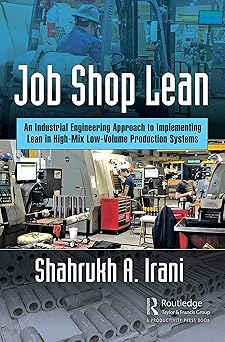
Job Shop Lean: An Industrial Engineering Approach to Implementing Lean in High-Mix Low-Volume Production Systems
by: Shahrukh A. Irani (Author)
Publisher: Productivity Press
Edition: 1st
Publication Date: 2020/5/18
Language: English
Print Length: 718 pages
ISBN-10: 0367472252
ISBN-13: 9780367472252
Book Description
In the 1950’s, the design and implementation of the Toyota Production System (TPS) within Toyota had begun. In the 1960’s, Group Technology (GT) and Cellular Manufacturing (CM) were used by Serck Audco Valves, a high-mix low-volume (HMLV) manufacturer in the United Kingdom, to guide enterprise-wide transformation. In 1996, the publication of the book Lean Thinking introduced the entire world to Lean. Job Shop Lean integrates Lean with GT and CM by using the five Principles of Lean to guide its implementation: (1) identify value, (2) map the value stream, (3) create flow, (4) establish pull, and (5) seek perfection. Unfortunately, the tools typically used to implement the Principles of Lean are incapable of solving the three Industrial Engineering problems that HMLV manufacturers face when implementing Lean: (1) finding the product families in a product mix with hundreds of different products, (2) designing a flexible factory layout that "fits" hundreds of different product routings, and (3) scheduling a multi-product multi-machine production system subject to finite capacity constraints.Based on the Author’s 20+ years of learning, teaching, researching, and implementing Job Shop Lean since 1999, this bookDescribes the concepts, tools, software, implementation methodology, and barriers to successful implementation of Lean in HMLV production systemsUtilizes Production Flow Analysis instead of Value Stream Mapping to eliminate waste in different levels of any HMLV manufacturing enterpriseSolves the three Industrial Engineering problems that were mentioned earlier using software like PFAST (Production Flow Analysis and Simplification Toolkit), Sgetti and SchedlyzerExplains how the one-at-a-time implementation of manufacturing cells constitutes a long-term strategy for Continuous ImprovementExplains how product families and manufacturing cells are the basis for implementing flexible automation, machine monitoring, virtual cells, Manufacturing Execution Systems, and other elements of Industry 4.0Teaches a new method, Value Network Mapping, to visualize large multi-product multi-machine production systems whose Value Streams share many processesIncludes real success stories of Job Shop Lean implementation in a variety of production systems such as a forge shop, a machine shop, a fabrication facility and a shipping departmentEncourages any HMLV manufacturer planning to implement Job Shop Lean to leverage the co-curricular and extracurricular programs of an Industrial Engineering department
About the Author
In the 1950’s, the design and implementation of the Toyota Production System (TPS) within Toyota had begun. In the 1960’s, Group Technology (GT) and Cellular Manufacturing (CM) were used by Serck Audco Valves, a high-mix low-volume (HMLV) manufacturer in the United Kingdom, to guide enterprise-wide transformation. In 1996, the publication of the book Lean Thinking introduced the entire world to Lean. Job Shop Lean integrates Lean with GT and CM by using the five Principles of Lean to guide its implementation: (1) identify value, (2) map the value stream, (3) create flow, (4) establish pull, and (5) seek perfection. Unfortunately, the tools typically used to implement the Principles of Lean are incapable of solving the three Industrial Engineering problems that HMLV manufacturers face when implementing Lean: (1) finding the product families in a product mix with hundreds of different products, (2) designing a flexible factory layout that "fits" hundreds of different product routings, and (3) scheduling a multi-product multi-machine production system subject to finite capacity constraints.Based on the Author’s 20+ years of learning, teaching, researching, and implementing Job Shop Lean since 1999, this bookDescribes the concepts, tools, software, implementation methodology, and barriers to successful implementation of Lean in HMLV production systemsUtilizes Production Flow Analysis instead of Value Stream Mapping to eliminate waste in different levels of any HMLV manufacturing enterpriseSolves the three Industrial Engineering problems that were mentioned earlier using software like PFAST (Production Flow Analysis and Simplification Toolkit), Sgetti and SchedlyzerExplains how the one-at-a-time implementation of manufacturing cells constitutes a long-term strategy for Continuous ImprovementExplains how product families and manufacturing cells are the basis for implementing flexible automation, machine monitoring, virtual cells, Manufacturing Execution Systems, and other elements of Industry 4.0Teaches a new method, Value Network Mapping, to visualize large multi-product multi-machine production systems whose Value Streams share many processesIncludes real success stories of Job Shop Lean implementation in a variety of production systems such as a forge shop, a machine shop, a fabrication facility and a shipping departmentEncourages any HMLV manufacturer planning to implement Job Shop Lean to leverage the co-curricular and extracurricular programs of an Industrial Engineering department
未经允许不得转载:电子书百科大全 » Job Shop Lean: An Industrial Engineering Approach to Implementing Lean in High-Mix Low-Volume Production Systems


评论前必须登录!
登陆 注册